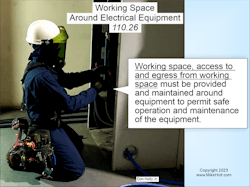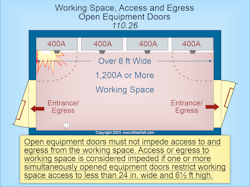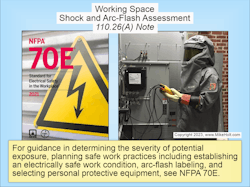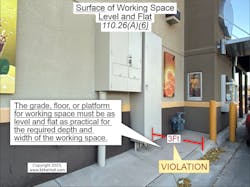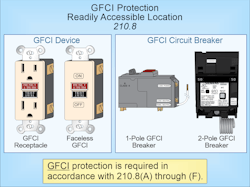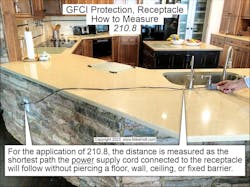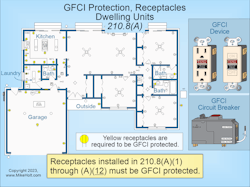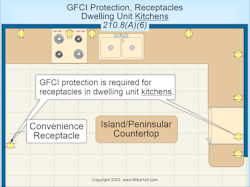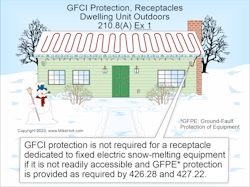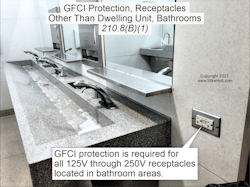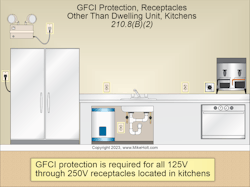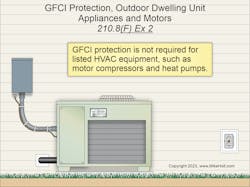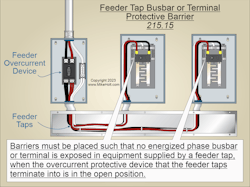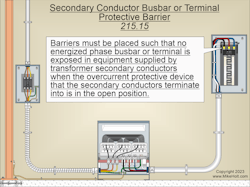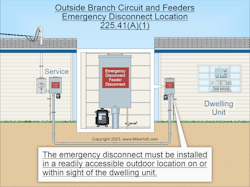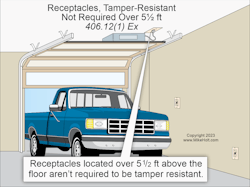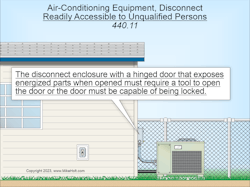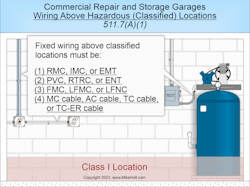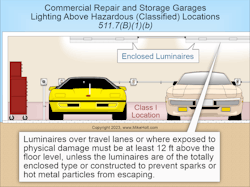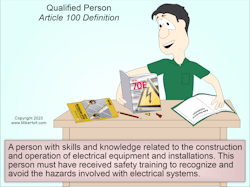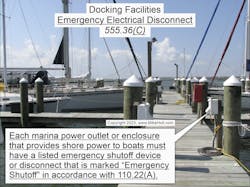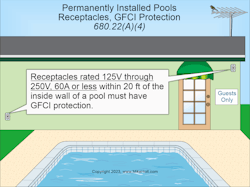Top Changes to the 2023 National Electrical Code
Key Takeaways
- Introduction of new medium-voltage Articles addressing systems over 1,000VAC and 1,500VDC, including Articles 235, 245, 305, 315, and 495, to support growing medium voltage installations.
- Reorganization of definitions into Article 100 and relocation of medium voltage requirements to improve clarity and alignment with the NEC Style Manual.
- Enhanced safety rules around electrical equipment spaces, including new requirements for unobstructed working spaces, equipment access, and egress, with specific provisions for equipment above suspended ceilings and crawl spaces.
- Expanded GFCI protection mandates across various locations, including kitchens, bathrooms, outdoor outlets, and areas near pools, with new exceptions and clarification for specific appliances and environments.
As it does every three years, the National Fire Protection Association (NFPA) recently released the latest edition of NFPA 70®, National Electrical Code®. The 2023 NEC cycle was very active with 4,006 Public Inputs, 1,805 First Revisions, 1,956 Public Comments, 900 Second Revisions, 164 Correlating Revisions, and 55 Certified Amending Motions. This resulted in several new Articles and a wide array of new and revised rules.
In addition to all this activity, it was a busy year for the correlating committee, which eliminated “subjective terms” and tasked the Code-Making Panels with reorganizing many of the rules that were long paragraphs into list formats. Long terms were replaced with acronyms when possible, and redundant language was removed throughout the Code. A couple of major changes globally include a sweeping relocation of definitions into Art. 100 as well as the relocation of medium voltage requirements into their own Articles. These changes align the existing NEC text with the NEC Style Manual requirements, making the NEC a more usable document.
Although they’re not part of our top 25 revision highlights, the following new Articles are worth noting.
New Medium Voltage Articles
Several new Articles were created to address the growing number of medium voltage installations that are being installed under the purview of the NEC. The medium voltage Articles that are in the 2023 NEC are:
• Article 235 — Branch Circuits, Feeders, and Services Over 1,000VAC, 1,500VDC, Nominal.
• Article 245 — Overcurrent Protection for Systems Rated Over 1,000VAC, 1,500VDC.
• Article 305 — General Requirements for Wiring Methods and Materials for Systems Rated Over 1,000VAC, 1,500VDC, Nominal. This Article replaces Art. 399 because Art. 305 is a more logical location for the information.
• Article 315 — Medium Voltage Conductors, Cable, Cable Joints, and Cable Terminations. This Article replaces Art. 311 in a more logical location for the information.
• Article 495 — Equipment Over 1,000VAC, 1,500VDC, Nominal. This Article replaces Art. 490.
Other New Articles Found in the 2023 NEC
A few other new Articles are home to new and relocated requirements, including:
• Article 369 — Insulated Bus Pipe (IBP)/Tubular Covered Conductors (TCC) Systems. The rules in this new Article are focused on a new product that is a cylindrical solid or hollow conductor with a solid insulation system, having conductive grading layers and a grounding layer embedded in the insulation and provided with an overall covering of insulating or metallic material.
• Article 371 — Flexible Bus Systems. The rules in this new Article are focused on engineered products like cable bus systems that are designed around the use of thin pieces of copper bus covered with insulation. It is installed in a support system much like a cable tray but is specifically designed for the flexible bus.
• Article 722 — Cables for Power-Limited Circuits, Fault-Managed Power Circuits, and Optical Fiber. This new Article creates a common set of cabling rules for Arts. 725, 760, and 770 to avoid repeating many of the common general requirements in each of those separate Articles.
• Article 724 — Class 1 Power-Limited Circuits and Class 1 Power-Limited Remote-Control and Signaling Circuits. This new Article was created for Class 1 power-limited circuits to separate them from Class 2 and Class 3 power-limited circuits. This revision adds clarity and better usability to the Code. Historically, Class 1 circuits were either nonpower-limited or power limited. But now Chapter 7 only addresses Class 1 power-limited circuits with a power limitation of 30V and 1,000VA. Nonpower-limited remote control and signaling circuits will be covered by the first four chapters of the NEC.
• Article 726 — Class 4 Fault-Managed Power Systems. This new Article covers a new class of power systems that provide excellent protection for people by limiting exposure times (short pulses or fast shut-off times) and eliminating repetitive impulses. In addition to increased personnel safety, these new systems use sophisticated monitoring and control techniques to provide better equipment monitoring and protection than a traditional overcurrent protective device (OCPD).
As you read through the analysis on each of the following changes, please note that the blue underlined text is NEW to the Code. Although it is slightly reworded or shortened from the actual text shown in the NEC, it’s a good representation of the intent of the real rule change.
Change #1
Section 110.26 Spaces About Electrical Equipment
Analysis of the change:
When it comes to important daily-use NEC rules, the general requirements for electrical equipment top the list — and the changes made to these rules in this Code cycle are subtle but impactful.
A requirement from Sec. 110.26(C)(2) in 2020 was relocated to the parent text that prohibits open doors from impeding the entry or egress path. The relocation makes it apply to all electrical installations — not just large equipment. This rule now specifies that when open equipment doors result in an egress path that is less than 24 in. wide or 6 ft, 6 in. high, the opening must be increased to prevent the equipment doors from impeding the egress path.
The requirement from Sec. 110.26(C)(2) that open equipment doors do not impede access to and egress from the working space was relocated to Sec. 110.26(A)(4). Revisions clarify that the space in front of equipment must be unobstructed by fixed cabinets, walls, or partitions. A weight-bearing ceiling structural member is permitted if it does not result in a side reach of more than 6 in. to access the equipment.
New Sec. 110.26(A)(6) requires the standing surface of the work area required by (A)(1), (A)(2), and (A)(3) to be level and as flat as practical for the entire required depth and width of the working surface. This addresses the required working space or attic installations where there are no floorboards to establish a surface for the electrical equipment.
New or revised Code language:
Section 110.26 Spaces Around Electrical Equipment
Working space, access to and egress from working space must be provided and maintained around equipment to permit safe operation and maintenance of equipment (see Fig. 1).
(A) Working Space. Equipment that may need examination, adjustment, servicing, or maintenance while energized must have working space provided per 110.26(A)(1), (2), (3), and (4).
Note: For guidance in determining the severity of potential exposure, planning safe work practices, including establishing an electrically safe work condition, arc-flash labeling, and selecting personal protective equipment, see NFPA 70E, Standard for Electrical Safety in the Workplace (see Fig. 3).
(4) Limited Access. Where equipment is likely to require examination, adjustment, servicing, or maintenance while energized is located above a suspended ceiling or crawl space, all the following conditions apply:
(1) Equipment installed above a suspended ceiling must have an access opening not smaller than 22 in. × 22 in., and equipment installed in a crawl space must have an accessible opening not smaller than 22 in. × 30 in.
(2) The width of the working space must be a minimum of 30 in. but in no case less than the width of the equipment.
(3) The working space must permit equipment doors to open 90°.
(4) The working space in front of the equipment must comply with the depth requirements of Table 110.26(A)(1) and be unobstructed to the floor by fixed cabinets, walls, or partitions. Horizontal ceiling structural members are permitted in this space provided the location of weight-bearing structural members does not result in a side reach of more than 6 in. to work within the enclosure. (6) Grade, Floor, or Working Platform. The grade, floor, or platform for the working space must be as level and flat as practical for the required depth and width of the working space (see Fig. 4 and Fig. 5).Change #2
Section 210.8 Ground-Fault Circuit-Interrupter Protection for Personnel
Analysis of the change:
For more than 30 years, ground-fault circuit-interrupter (GFCI) requirements have been added to the NEC, and this Code cycle continues that trend. The term “listed Class A GFCI” replaced “ground-fault circuit-interrupter” throughout the rule. It is now clear that the path of measurement for a power-supply cord is related to the receptacle — not the appliance from which it came. An interesting Exception was added for exhaust fans, non-dwelling GFCI requirements have taken over in food service areas, and protection is required for all outlets in garages, accessory buildings, and boathouses. Protection is also required for baitwells and aquariums. These rules now basically say that where there is water you need a GFCI.
The term “ground-fault circuit-interrupter” throughout this Section was changed to “listed Class A GFCI” because acronyms are now permitted to be used in the NEC. In addition, the charging text (indicating how measurements are to be made) was revised to clarify that the measurement applies to all power-supply cords plugged into a receptacle — not just appliance cords.
New or revised Code language:
Section 210.8 Ground-Fault Circuit-Interrupter Protection for Personnel
A listed Class A ground-fault circuit interrupter (GFCI) must provide protection as required in Sec. 210.8(A) through (F). The GFCI protective device must be in a readily accessible location (see Fig. 6).
Author’s Comment:
• The GFCI protection required by Sec. 210.8(A) and (B) can be provided using either a breaker with GFCI protection or a receptacle with GFCI protection. However, the use of a GFCI receptacle is somewhat limited by the requirement that the GFCI must be readily accessible.
For the application of Secs. 210.8(A)(8), 210.8(A)(10), 210.8(B)(7), 210.8(B)(13), and 210.8(B)(15), the distance (from the sink or bathtub/shower) is measured as the shortest path the power-supply cord connected to the receptacle will follow without piercing a floor, wall, ceiling, or fixed barrier (see Fig. 7).Change #3
Section 210.8(A) Dwelling UnitsAnalysis of the change:The phrase “receptacles serving the countertop” was removed from (A)(6), thereby expanding the GFCI protection requirement to include any cord- and plug-connected appliance in kitchens, not just on countertops.
A new (A)7 requires areas with sinks and permanent provisions for food preparation, beverage preparation, or cooking to have GFCI-protected receptacles.
The Exceptions that previously followed the list items in Sec. 210.8(A) were relocated to follow the last list item. Clarifications were also made as to when the Exception(s) applies, but there were no technical changes.
A new Exception No. 4 was added to say that the internal receptacle in a bathroom exhaust fan does not require GFCI protection unless required by the installation or listing instructions. This receptacle is not easily accessed (and is not used as a convenience receptacle), so this exception makes sense.
New or revised Code language:
Section 210.8(A) Dwelling Units
Receptacles installed in the following dwelling unit
locations must be GFCI-protected (see Fig. 8).
Author’s Comment:
• Traditionally, this requirement only applied to kitchen countertop receptacles. Now, any cord- and plug-connected appliance in the kitchen, such as the range receptacle, refrigerator receptacle, disposal receptacle, and microwave receptacles, will require GFCI protection.
(7) Food Preparation Areas. GFCI protection is required for receptacles in areas with sinks with permanent provisions for food preparation, beverage preparation, or cooking. Exception No. 1: GFCI protection is not required for a receptacle dedicated to fixed electric snow-melting equipment if the receptacle is not readily accessible and ground-fault protection of equipment (GFPE) is provided as required by Sec. 426.28 and Sec. 427.22 (see Fig. 10).Author’s Comment:
• The receptacle for exhaust fans is internal to the exhaust fan and is not accessible as a convenience cord-and-plug receptacle; therefore, GFCI protection is not required. Per the UL GPWX guide information, exhaust fans installed in the area directly above the footprint of the bathtub or shower must be GFCI protected.
Change #4
Section 210.8(B) Other Than DwellingsAnalysis of the change:The word “kitchens” was added as list item (2) and removed from list item (3). This change clarifies that all areas with permanent provisions for food serving, beverage service, or cooking must be protected.
List item (4) was added to include buffet areas and beverage serving areas in the GFCI requirements. This is kind of an open-ended rule using the term “area” instead of a specific distance, as is used in list item (7), and it may cause some problems with enforcement. Only time will tell.
List item (7) expands the requirement in other than dwellings to protect electric appliances — not just receptacles located within 6 ft of a sink. This lets us know that the rule is about the hazard from both the appliance and its supplying receptacle.
A new rule in (13) requires GFCI protection for receptacles within 6 ft of the top inside edge or conductive support framing of aquariums, baitwells, and similar aquatic vessels.
New or revised Code language:
Section 210.8(B) Other Than Dwellings
GFCI protection is required for 125V through 250V receptacles supplied by single-phase branch circuits 50A or less, and receptacles supplied by 3-phase branch circuits 100A or less installed in the following locations:(1) Bathrooms. GFCI protection is required for receptacles in bathroom areas (see Fig. 12).
Author’s Comment:
• According to Art. 100, a “bathroom area” includes a sink (basin) and one or more of the following: a toilet, urinal, tub, shower, bidet, or similar plumbing fixture.
(2) Kitchens. GFCI protection is required for 125V through 250V receptacles in kitchens (see Fig. 13).Author’s Comment:
• This requires GFCI protection for receptacles in the break area of a commercial occupancy.
(7) Sinks. GFCI protection is required for 125V through 250V receptacles and receptacles used for cord- and plug-connected appliances located within 6 ft from the top inside edge of the bowl of a sink (see Fig. 14).Change #5
Section 210.8(D) Specific AppliancesAnalysis of the change:Changes in Sec. 210.8(D) now require GFCI protection to be provided for the branch circuit or the outlet supplying listed appliances rated 150V to ground and 60A or less. This rule previously referenced other Sections to determine if protection was required. Now you can just read the list here.
In addition to the seven items that were previously referenced in Art. 422, appliances requiring GFCI protection, five more appliances have been added, including electric ranges, wall-mounted ovens, counter-mounted cooking units, clothes dryers, and microwave ovens. This expansion of the GFCI requirements applies to both cord- and plug-connected as well as hardwired equipment.
New or revised Code language:
Section 210.8(D) Specific
Appliances
GFCI protection is required for the outlet supplying the following appliances rated 150V or less to ground, 60A or less, single- or three-phase: (1) Automotive vacuum machines(2) Drinking water coolers and bottle fill stations(3) High-pressure spray washing machines(4) Tire inflation machines (5) Vending machines (6) Sump pumps (7) Dishwashers (8) Electric ranges (9) Wall-mounted electric ovens (10) Counter-mounted electric cooking units(11) Clothes dryers (12) Microwave ovensAuthor’s Comment:
• The appliances in list items Sec. 210.8(D)(8) through (12) are commonly installed as hardwired outlets, and the GFCI protection requirements of Sec. 210.8(A) and (B) only apply to receptacles. The shock hazards exist whether appliances are hardwired or cord- and plug-connected; therefore, GFCI protection must be provided for the appliance branch circuit or outlet.
Change #6
Section 210.8(F) Outdoor Dwelling Unit OutletsAnalysis of the change:The rule in Sec. 210.8(F) for outdoor outlets was new in the 2020 Code, and its introduction caused a big problem with air-conditioning units in areas outside of dwelling units. The battle over its introduction continued during the 2023 Code cycle, which ultimately resulted in a new exception for listed HVAC equipment.
In addition, the dwelling unit receptacles rated 50A or less in garages, accessory buildings, outdoors, and boathouses that already had GFCI protection requirements now require the outlet to be protected, and GFCI protection must be added for unprotected existing equipment that is replaced.
New or revised Code language:
Section 210.8(F) Outdoor Dwelling Unit Outlets
GFCI protection is required for outdoor outlets rated 50A or less and outlets in the following dwelling unit areas (see Fig. 15):
Change #7
Section 210.17 Branch Circuits in Guest Rooms and Guest SuitesAnalysis of the change:You need to sit up and take notice of this change. Assisted living facilities with permanent provisions for cooking were added to the list of guest rooms and guest suites that must now have branch circuits installed to meet the dwelling unit requirements.
This rule was reorganized into a list, and the new list item (3), “assisted living facilities,” lets us know that if guest rooms or guest suites in hotels, motels, and assisted living facilities include permanent provisions for cooking, then the dwelling unit branch-circuit rules must be met. A new Informational Note directs us to NFPA 101, Life Safety Code, for the definition of an “assisted living facility.”
New or revised Code language:
Section 210.17 Guest Rooms and Guest Suites
Guest rooms and guest suites with permanent provisions for cooking located in the following areas must have branch circuits installed to meet the rules for dwelling units: (1) Hotels (2) Motels (3) Assisted living facilities Note 2: For the definition of assisted living facilities, see NFPA 101, Life Safety Code.Author’s Comment:
• Per NFPA 101, Sec. 3.3.198.12(5), an assisted living facility is defined as an occupancy used for the lodging and boarding of four or more residents for the purposes of providing personal care services.
Change #8
Section 215.15 Barriers in Electrical EquipmentAnalysis of the change:
This new Section requires the line-side busbar or terminals of equipment supplied by feeder taps or transformer secondary conductors to be protected from inadvertent contact by placing barriers over the exposed energized parts. This mirrors the line-side barrier protection requirements for services found in Sec. 230.62(C) and applies to panelboards, switchboards, switchgear, or motor control centers supplied by feeder taps or transformer secondary conductors.
New or revised Code language:
Section 215.15 Barriers Feeder Taps. Barriers must be placed such that no energized phase busbar or terminal is exposed in equipment supplied by a feeder tap [Sec. 240.21(B)] when the overcurrent protective device into which the feeder taps terminate is in the open position (see Fig. 17).Author’s Comment:
• During maintenance and servicing, it is very likely an electrical worker can be exposed to inadvertent contact with energized parts on the line side of a feeder tap or secondary conductor disconnect, even if the disconnect is in the open position. Barriers on feeder tap and transformer secondary conductor disconnects reduce the hazards that exist and create an electrically safe work condition.
Change #9
Section 220.70 Energy Management SystemsAnalysis of the change:A new Section was added for energy management systems that can control the maximum load of a service. Digital control has become a big part of our electrical systems. This new Section allows an energy management system to limit the maximum current used by the electrical system. There will undoubtedly be growing pains with this rule; however, it is a major step forward in integrating digital control with power systems on a large scale.
New or revised Code language:
Section 220.70 Energy Management SystemsIf an energy management system is used to limit the current to a feeder or service per Sec. 750.30(C)(1)(2), the maximum ampere setpoint of the energy management system can be used in load calculations. The setpoint value of the energy management system is considered a continuous load.Change #10
Section 225.41 Emergency DisconnectsAnalysis of the change:This new Section requires outside emergency disconnects for feeders supplied to one- and two-family dwelling units. This mirrors the requirements in Sec. 230.85 for service-supplied dwelling units so first responders are always able to shut off the power on the exterior of a dwelling — regardless of how it is supplied. Section 225.41(B) requires the
identification of the location of other isolation disconnects for other power sources where those disconnects are not located adjacent to the emergency disconnect.
New or revised Code language:
Section 225.41 Emergency Disconnects For one- and two-family dwelling units, an emergency disconnect must be installed for first responders and others. (A) General. (1) Location. The emergency disconnect must be installed in a readily accessible outdoor location on or within sight of the dwelling unit (see Fig. 19).Change #11
Section 406.12 Tamper-Resistant ReceptaclesAnalysis of the change:Tamper-resistant receptacles have been protecting curious minds for years now. In this Code cycle, additional locations that require protection were added to the list.
Exception No. 3 was clarified to say that a single receptacle for a single appliance or a duplex receptacle for two appliances, not readily accessible and located within the space designated for the appliance(s), are exempt from this rule.
New or revised Code language:
Section 406.12 Tamper-Resistant Receptacles
Nonlocking-type 15A and 20A receptacles in the following areas must be tamper-resistant (TR):
(1) In dwelling units, boathouses, mobile homes, and manufactured homes, including their attached and detached garages and accessory buildings, and common areas of multifamily dwellings (see Fig. 20).(2) In hotel and motel guest rooms and guest suites, and their common areas.
(3) In childcare facilities.
Author’s Comment:
• A childcare facility is a building or portion of a building used for educational, supervision, or personal care services for five or more children seven years in age or less [Art. 100].
(4) In preschools and education facilities.
Author’s Comment:
• This applies to all educational facilities, including high schools, colleges, vocational schools, universities, and so forth.
(5) Within clinics, medical and dental offices, outpatient facilities, and the following spaces: a. Business offices accessible to the general public b. Lobbies and waiting spaces c. Spaces of nursing homes and limited care facilities used exclusively as patient sleeping rooms(6) Places of awaiting transportation, gymnasiums, skating rinks, fitness centers, and auditoriums.(7) Dormitory units.
(8) Residential care/assisted living facilities, social and substance abuse rehabilitation facilities, and group homes. (9) Foster care facilities, nursing homes, and psychiatric hospitals. (10) Areas and common areas of agricultural buildings accessible to the general public. Note 3: Areas of agricultural buildings frequently converted to hospitality areas include petting zoos, stables, and buildings used for recreation or educational purposes.Exception to (1) through (10): Receptacles in the following locations are not required to be tamper-resistant:(1) Receptacles more than 5½ ft above the floor (see Fig. 21).
(2) Receptacles that are part of a luminaire or appliance.
(3) A receptacle within a dedicated space for an appliance that in normal use is not easily moved.
(4) Nongrounding receptacles installed as permitted in 406.4(D)(2)(a).
Change #12
Section 410.184 Ground-Fault Circuit-Interrupter (GFCI) Protection and Special Purpose Ground-Fault Circuit-Interrupter (SPGFCI) ProtectionAnalysis of the change:As the horticultural lighting industry grows, so do the hazards associated with the increasing number of installations. To address some of these hazards, it was clarified that GFCI protection is required where the horticultural lighting is connected with flexible cords using separable connectors or attachment plugs.
A new Exception allows lighting equipment supplied by circuits over 150V to be protected with a listed special-purpose ground-fault circuit interrupter that trips at 20mA instead of 6mA.
New or revised Code language:
Section 410.184 GFCI and Special Purpose GFCI ProtectionLighting equipment identified for horticultural use using flexible cord(s) with separable connector(s) or attachment plug(s) must be supplied by GFCI-protected lighting outlets. Exception: Circuits exceeding 150V to ground must be protected by a listed special-purpose ground-fault circuit interrupter.Change #13
Section 440.11 GeneralAnalysis of the change:Disconnects in dwelling units are often accessible to homeowners and children. To prevent a hazard from energized parts, this rule was revised to require disconnecting means with doors that can open to expose live parts to be lockable or require tools to open them when installed in areas readily accessible to unqualified persons.
New or revised Code language:
Section 440.11 General
If the air-conditioning disconnecting means is readily accessible to unqualified persons, the disconnect enclosure or hinged door that exposes energized parts when opened must require a tool to open or be capable of being locked (see Fig. 22).Change #14
Section 500.4 DocumentationAnalysis of the change:Revisions this cycle clarify that area classification documentation must be available for both classified and adjacent unclassified areas. This is an important rule, since the area classification specifies the installation methods required by Arts. 501, 502, and 503. An area classification drawing is required along with other associated proper documentation. Language was also added requiring the documentation to be made available to the AHJ.
New or revised Code language:
Section 500.4 Documentation
Areas designated as hazardous (classified) locations or determined to be unclassified must be documented on an area classification drawing and other associated documentation. The documentation must be available to the authority having jurisdiction (AHJ) and those who are authorized to design, install, inspect, maintain, or operate the electrical equipment.Author’s Comments:
• Proper documentation of hazardous (classified) locations assists the designer, installer, and authority having jurisdiction in ensuring adherence to the stringent requirements contained in Arts. 501 through 517. The required classification drawings must indicate the hazardous location (classified) location area classification(s) and the boundaries between classified and unclassified areas, material group properties such as auto-ignition temperatures, and equipment construction suitability.
• Articles 511 through 517 provide established details on the areas that are classified for those occupancies. Additional determination of classified areas is not required for those areas that are classified by those articles. Determining the classification of a specific hazardous (classified) location area is the responsibility of those who understand the dangers of the products being used such as the fire marshal, plant facility engineer, or insurance underwriter. It is not the responsibility of the electrical designer, electrical contractor, or electrical inspector. Before performing any wiring in or near a hazardous (classified) location, contact the plant facility and design engineer to ensure that proper installation methods and materials are used. Be sure to review Sec. 500.4(B) for additional standards that might need to be consulted.
Change #15
Section 511.7 Wiring and Equipment Installed Above Hazardous (Classified) LocationsAnalysis of the change:This Section went through quite a transformation as it was reorganized into a list format with additional requirements for listed fittings and equipment grounding conductors (EGCs) added to the mix.
The term “Class I” was replaced by “Hazardous (Classified)” in five locations, including the title of this Section, as the zone classification system no longer uses the “Class I” designation. This Section was also reorganized from a long paragraph into nine list items for usability, and requirements were added to most of the wiring methods.
The rule in (A)(1) permits the use of rigid metal conduit (RMC), intermediate metal conduit (IMC), and electrical metallic tubing (EMT). The additional language specifies that RMC and IMC must be used with listed threaded or threadless fittings, and EMT must be used with listed fittings.
- List item (2) previously specified RMC, but the reference has been incorrect since the 2008 Code when the title of Art. 352 was changed to rigid polyvinyl chloride conduit, and RTRC was given its own Article [Art. 355.]
- List Item (3) permits flexible metal conduit (FMC), liquidtight flexible metal conduit (LFMC), and liquidtight flexible nonmetallic conduit (LFNC) conduit and requires listed fittings.
- Item (4) covers AC, MC, TC, and TC-ER cables. Type TC-ER cable must have an EGC and be terminated using listed fittings.
New or revised Code language:
Section 511.7 Wiring and Equipment Above Hazardous (Classified) Locations (A) Wiring in Spaces Above Hazardous (Classified) Locations. (1) Fixed Wiring Above Hazardous (Classified) Locations. Fixed wiring above hazardous (classified) locations is permitted by one or more of the following wiring methods (see Fig. 23):(2) Pendant (Drop-Cords). For pendants, a flexible cord suitable for the type of service and listed for hard usage must be used.
(B) Equipment Above Hazardous (Classified) Locations.(1) Fixed Electrical Equipment. Fixed electrical equipment must be above the level of any defined hazardous (classified) location or be identified for the location.(a) Arcing Equipment. Equipment with make-and-break contacts installed less than 12 ft above the floor level must be of the totally enclosed type or constructed to prevent sparks or hot metal particles from escaping.
(b) Fixed Lighting. Luminaires over travel lanes or where exposed to physical damage must be at least 12 ft above the floor level unless the luminaires are of the totally enclosed type or constructed to prevent sparks or hot metal particles from escaping (see Fig. 24).
Change #16
Section 555.4 Location of Service EquipmentAnalysis of the change:The rules for docking facilities have garnered a lot of attention in the last few Code cycles due to the unfortunate number of accidents in and near the water. Two changes as to the location of the service equipment require the service equipment to be no closer than 5 ft horizontally from the water and at least 12 in. above the electrical datum plane.
New or revised Code language:
Section 555.4 Location of Service Equipment
The service equipment for a floating dock or marina must be on land no closer than 5 ft horizontally from the water. Service equipment must be located no less than 12 in. above the electrical datum plane.Change #17
Section 555.15 Replacement of EquipmentAnalysis of the change:A new Section was added on how to deal with equipment that is replaced at docking facilities. This is a huge change for those in the marine industry. This new Section requires that where electrical equipment is modified or replaced at a docking facility, those repairs, modifications, or replacements must comply with the provisions of the NEC. The circuit that supplies the equipment must then be inspected. If existing equipment is damaged, it must be identified, documented, and repaired by a qualified person to the minimum requirements of the edition of this Code to which it was originally installed.
New or revised Code language:
Section 555.15 Replacement of EquipmentModifications and Replaced Equipment. Modification or replacement of electrical enclosures, devices, or wiring on a docking facility must comply with the provisions of this Code and the installation requires an inspection of the entire circuit. Existing Equipment. Existing equipment that has been damaged must be identified, documented, and repaired by a qualified person to the minimum requirements of the edition of this Code to which it was originally installed.Author’s Comment:
• According to Art. 100, the definition of a qualified person is “a person with skills and knowledge related to the construction and operation of electrical equipment and installations. This person must have received safety training to recognize and avoid the hazards involved with electrical systems” (see Fig. 25).
Change #18
Section 555.36 Shore Power Receptacle Disconnecting MeansAnalysis of the change:The new subdivision (C) requires an externally operable emergency disconnect, clearly marked “Emergency Shutoff” that can de-energize all power at each marina power outlet or enclosure that provides shore power to boats. An emergency disconnect within sight of the marina power outlet will provide bystanders with the ability to shut off power if a swimmer comes into contact with an energized metal boat, dock, or ladder. As this rule is implemented in marinas, it will help to eliminate electric shock drownings (ESDs).
New or revised Code language:
555.36 Shore Power Receptacle Disconnecting Means
(C) Emergency Electrical Disconnect. Each marina power outlet or enclosure that provides shore power to boats must have a listed emergency shutoff device or disconnect that is marked “Emergency Shutoff” per Sec. 110.22(A) (see Fig. 26).Authors Comment:
• An emergency disconnect within sight of the marina power outlet will provide bystanders with the ability to shut off power if a swimmer comes into contact with an energized metal boat, dock, or ladder — and in cases where it appears that electric shock drowning (ESD) is occurring.
Change #19
Section 625.40 Electric Vehicle Branch CircuitAnalysis of the change:Multiple units of EVSE can finally share a circuit. It’s about time! EVSE circuits were previously required to be individual branch circuits. A new Exception permits multiple units of EVSE drawing 16A or less, at 120V, to share a circuit. Some EVSE systems use load management systems that limit the combined current draw on the circuit, allowing multiple systems to be supplied by a single circuit without causing an overload.
New or revised Code language:
Section 625.40 Electric Vehicle Branch Circuit
Electric vehicle supply equipment rated greater than 16A or greater than 120V must be supplied by an individual branch circuit. Exception: A single branch circuit is permitted to supply more than one electric vehicle supply equipment when the loads are managed by an energy management system per Sec. 625.42(A) or (B).Change #20
Section 625.49 Island Mode (Electric Vehicle Power Transfer System)Analysis of the change:We were all waiting for the day when we could use our electric car to provide power to our homes during an outage. Well, this new Section permits EVPE and bidirectional EVSE that have a power export function to be part of an interconnected power system operating in island mode.
New or revised Code language:
Section 625.49 Island ModeElectric vehicle power export equipment (EVPE) and bidirectional electric vehicle supply equipment (EVSE) that incorporate a power export function are permitted to be a part of an interconnected power system operating in island mode.Change #21
Section 680.5 Ground-Fault Circuit-Interrupter (GFCI) and Special Purpose Ground-Fault Circuit-Interrupter (SPGFCI) ProtectionAnalysis of the change:This Section was revised and expanded to include special-purpose ground-fault circuit interrupters (GFCIs) and now has three subdivisions. Subdivision (A) covers the general requirements, (B) covers GFCIs for applications up to 150V to ground, and (C) covers SPGFCIs for applications over 150V to ground.
The new subdivision (C) addresses SPGFCI protection for circuits over 150V to ground. The intent is to protect pool equipment in commercial installations that have higher voltages. A new Informational Note references UL 943C, which tells us the threshold ground-fault trip current is not to exceed 20mA.
New or revised Code language:
Section 680.5 GFCI and SPGFCI Protectio (C) Above 150V to Ground.. Where ground-fault protection is required in this Article for branch circuits rated over 150V to ground, an SPGFCI device must be used.Author’s Comment:
• A GFCI protective device is intended to protect humans against maximum let-go levels (muscle contraction) for circuits rated not over 150V to ground, with a trip-open value of 6mA. An SPGFCI protective device is intended to protect humans against ventricular fibrillation (electrocution) for circuits above 150V to ground with a trip-open value of 20mA.
Change #22
Section 680.22 Receptacles, Luminaires, and SwitchesAnalysis of the change:The requirements for GFCI protection of receptacles in (A)(4) were expanded this cycle to include all receptacles rated 60A or less within 20 ft of a pool wall. This previously only applied to 15A and 20A, 125V receptacles.
This Section also required GFCI protection for specific equipment installed in the area between 5 ft and 10 ft horizontally from the inside walls of a pool. New language in (B)(4) expands the required protection by adding an SPGFCI requirement that will allow equipment operating above 150V to ground to also be protected.
New or revised Code language:
Section 680.22 Receptacles, Luminaires, and Switches
(A) Receptacles.
(4) GFCI and SPGFCI Protection.Receptacles rated 125V through 250V, 60A or less, and 150V or less to ground within 20 ft of the inside wall of a pool must have GFCI protection. Receptacles rated above 150V to ground within 20 ft of the inside wall of a pool must have special-purpose GFCI protection (see Fig. 27).(B) Luminaires and Ceiling Fans.
(4) GFCI and SPGFCI Protection. All luminaires, lighting outlets, and ceiling fans between 5 ft and 10 ft horizontally from the inside walls of a permanently installed pool, and not less than 5 ft above the maximum water level, must have GFCI protection per Sec. 680.5(B) or SPGFCI protection per Sec. 680.5(C).Change #23
Section 700.3 Tests and MaintenanceAnalysis of the change:Commissioning is a regular part of larger jobs, and now changes to test and maintenance protocols require emergency systems to be commissioned. To make this enforceable, revisions to (A) now require commissioning and not just testing of the emergency system. The term “commissioning” is defined in Art. 100, in part, as the process, procedures, and testing used to set up and verify the operation of electrical devices and equipment before being placed into active service.
New or revised Code language:
Section 700.3 Tests and Maintenance
(A) Commissioning Witness Test. To ensure the emergency power system meets or exceeds the original installation specifications, the authority having jurisdiction must conduct or witness the commissioning of the emergency power system upon completion. Note: See NECA 90, Standard for Commissioning Building Electrical Systems.Change #24
Section 700.11 Wiring, Class-2-Powered Emergency Lighting SystemsAnalysis of the change:Since the PoE lighting train is gaining momentum, a new Section for Class 2 wiring provides the requirements for these systems. This is a great start. This new Section addresses technologies such as PoE and other emergency lighting systems that utilize Class 2 power. The other rules in this Article address line voltage systems, and this new Section provides requirements for low-voltage emergency systems. This Section is a great start, and I know we will see continued improvement in the rules as they mature.
New or revised Code language:
Section 700.11 Wiring, Class-2-Powered Emergency Lighting Systems (A) General. Line voltage supply wiring and Class 2 power-limited emergency lighting control devices must comply with Sec. 700.10. Class 2 power-limited emergency circuits must comply with Sec. 700.11(B) through (D). (B) Identification. Class 2 power-limited emergency circuits must be permanently marked so they will be readily identified as a component of an emergency circuit or system by the following methods: (1) All boxes and enclosures for Class 2 power-limited emergency circuits must be permanently marked as a component of an emergency circuit or system. (2) Exposed cable, cable tray, or raceway systems must be permanently marked to be identified as a component of an emergency circuit or system within 3 ft of each connector and at intervals not to exceed 25 ft. (C) Separation of Circuits. Class 2 power-limited emergency circuits must be wired in a listed, jacketed cable or with one of the wiring methods of Chapter 3. If installed alongside nonemergency Class 2 power-limited circuits that are bundled, Class 2 power-limited emergency circuits must be bundled separately. If installed alongside nonemergency Class 2 power-limited circuits that are not bundled, Class 2 power-limited emergency circuits must be separated by a nonconductive sleeve or nonconductive barrier from all other Class 2 power-limited circuits. Separation from other circuits must comply with Sec. 725.136. (D) Protection. Wiring must comply with the requirements of Sec. 300.4 and be installed in a raceway, armored or metal-clad cable, or cable tray. Exception No. 1: Section 700.11(D) does not apply to wiring that does not exceed 6 ft in length and that terminates at an emergency luminaire or an emergency lighting control device. Exception No. 2: Section 700.11(D) does not apply to locked rooms or locked enclosures that are accessible only to qualified persons. Note: Locked rooms accessible only to qualified persons include locked telecommunications rooms, locked electrical equipment rooms, or other access-controlled areas.Change #25
Section 706.7 Commissioning and Maintenance of Energy Storage SystemsAnalysis of the change:Energy storage systems (ESSs) are becoming a popular alternative to generators in certain applications. Making sure these systems function correctly often requires a specific set of performance tests. This Section title was changed to recognize these tests, and a new subdivision (A) requires ESSs to be commissioned upon installation in other than one- and two-family dwellings. The maintenance requirements became subdivision (B).
New or revised Code language:
Section 706.7 Commissioning and Maintenance (A) Commissioning. For other than one- and two-family dwelling units, energy storage systems (ESS) must be commissioned upon installation. Note: For information related to the commissioning of ESSs, see NFPA 855, Standard for the Installation of Stationary Energy Storage Systems. (B) Maintenance. For other than one- and two-family dwelling units, ESSs must be maintained in proper and safe operating conditions per the manufacturer’s requirements and industry standards. A written record of the system maintenance must be kept and include records of repairs and replacements necessary to maintain the system in a proper and safe operating condition.Note: For information related to general electrical equipment maintenance and developing an effective electrical preventive maintenance (EPM) program, see NFPA 70B, Recommended Practice for Electrical Equipment Maintenance, or ANSI/NETA ATS-2017, Standard for Acceptance Testing Specifications for Electrical Power Equipment and Systems.
About the Author

Mike Holt
Mike Holt is the owner of Mike Holt Enterprises (www.MikeHolt.com), one of the largest electrical publishers in the United States. He earned a master's degree in the Business Administration Program (MBA) from the University of Miami. He earned his reputation as a National Electrical Code (NEC) expert by working his way up through the electrical trade. Formally a construction editor for two different trade publications, Mike started his career as an apprentice electrician and eventually became a master electrician, an electrical inspector, a contractor, and an educator. Mike has taught more than 1,000 classes on 30 different electrical-related subjects — ranging from alarm installations to exam preparation and voltage drop calculations. He continues to produce seminars, videos, books, and online training for the trade as well as contribute monthly Code content to EC&M magazine.

